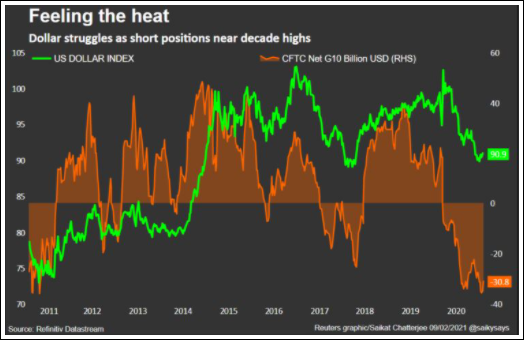NEW YORK, February 9 (Reuters) - The dollar fell to a one-week low on Tuesday, as a slide in U.S. Treasury yields raised doubts about the outlook for the greenback against the backdrop of a looming U.S. fiscal stimulus package.
But Bitcoin soared to a new record high, on its way toward another key milestone: $50,000. It has surged more than 1,000% since March 2020 at the beginning of pandemic and analysts said forecasts of bitcoin hitting $100,000 this year doesn’t seem far-fetched after all.
Market participants pushed up the dollar recently as Democrats moved to fast-track President Joe Biden’s $1.9 trillion COVID-19 relief package. But some analysts say massive fiscal spending and continued ultra-easy Federal Reserve monetary policy will ultimately prove to be a dollar headwind.
“Investors may be registering concerns that the fiscal stimulus will boost the U.S. current account deficit and we concur that structural imbalances remain a weakness in the longer run outlook for the U.S. dollar, especially amid reduced U.S. growth and yield differentials,” said Shaun Osborne, chief foreign exchange strategist, at Scotiabank in Toronto.
U.S. benchmark 10-year U.S. Treasury yields rose to near March 2020 highs on Monday as investors bet on a broader reflationary theme in the financial markets. But it slipped back to 1.14%, down 5 basis points from Monday’s session.
The dollar index was 0.4% lower at 90.58, after earlier hitting a one-week low.
Disappointing U.S. jobs data on Friday knocked the wind out of a two-week run that had lifted the dollar to a more than two-month high of 91.60.
Osborne said dollar losses at this point were a little premature, “especially as positioning indicators suggest that active traders continue to reduce what remains a fairly significant U.S. dollar short exposure.”

Tuesday raised familiar doubts among investors, with some traders saying fresh fiscal stimulus along with record-low U.S. interest rates will weigh on the currency in the coming months.
“The reflation trade that boosted equities and caused the 30-year yield breach 2% has changed to worries that a quick spike in inflation would be detrimental to risk and also the dollar,” said John Doyle, vice president of dealing and trading, at Monex Inc. in Washington.
BLISTERING BITCOIN
The biggest beneficiary of the weakening dollar was cryptocurrencies with bitcoin rocketing above $48,000, building on a nearly 20% surge overnight after Tesla Inc announced a $1.5 billion investment in the digital asset.
The yen was another major beneficiary, with the Japanese unit rising 0.6% against the U.S. dollar to 104.69 yen.
The yen has become increasingly correlated with outright yields rather than an indicator of broad risk sentiment. A 90-day rolling correlation between yen and U.S. yields has strengthened considerably since the final quarter of 2020.
Elsewhere, the euro rose 0.4% to $1.2096 on Tuesday, up from a two-month low of $1.1952 touched Friday.
The British pound revisited its highs since May 2018. It last traded up 0.4% at $1.3787.





